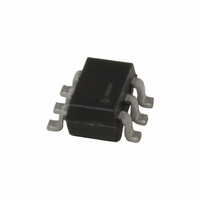MIC5211-LXYM6 TR Micrel Inc, MIC5211-LXYM6 TR Datasheet - Page 7

MIC5211-LXYM6 TR
Manufacturer Part Number
MIC5211-LXYM6 TR
Description
MIC5211-3.3/5.0YM6 Dual Cap 50mA LDO ( )
Manufacturer
Micrel Inc
Datasheet
1.MIC5211-3.3YM6_TR.pdf
(9 pages)
Specifications of MIC5211-LXYM6 TR
Regulator Topology
Positive Fixed
Voltage - Output
3.3V, 5V
Voltage - Input
2.5 ~ 16 V
Voltage - Dropout (typical)
0.25V @ 50mA
Number Of Regulators
2
Current - Output
50mA
Operating Temperature
-40°C ~ 125°C
Mounting Type
Surface Mount
Package / Case
SOT-23-6
Lead Free Status / RoHS Status
Lead free / RoHS Compliant
Current - Limit (min)
-
Lead Free Status / RoHS Status
Lead free / RoHS Compliant
Other names
576-2749-2
MIC5211-LXYM6 TR
MIC5211-LXYM6TR
MIC5211-LXYM6TR
MIC5211-LXYM6 TR
MIC5211-LXYM6TR
MIC5211-LXYM6TR
MIC5211
Applications Information
Enable/Shutdown
ENA and ENB (enable/shutdown) may be controlled sepa-
rately. Forcing ENA/B high (>2V) enables the regulator. The
enable inputs typically draw only 15µA.
While the logic threshold is TTL/CMOS compatible, ENA/B
may be forced as high as 20V, independent of V
be connected to the supply if the function is not required.
Input Capacitor
A 0.1µF capacitor should be placed from IN to GND if there
is more than 10 inches of wire between the input and the ac
filter capacitor or when a battery is used as the input.
Output Capacitor
Typical PNP based regulators require an output capacitor
to prevent oscillation. The MIC5211 is ultrastable, requiring
only 0.1µF of output capacitance per regulator for stability.
The regulator is stable with all types of capacitors, includ-
ing the tiny, low-ESR ceramic chip capacitors. The output
capacitor value can be increased without limit to improve
transient response.
The capacitor should have a resonant frequency above
500kHz. Ceramic capacitors work, but some dielectrics have
poor temperature coefficients, which will affect the value of
the output capacitor over temperature. Tantalum capacitors
are much more stable over temperature, but typically are
larger and more expensive. Aluminum electrolytic capacitors
will also work, but they have electrolytes that freeze at about
–30°C. Tantalum or ceramic capacitors are recommended
for operation below –25°C.
No-Load Stability
The MIC5211 will remain stable and in regulation with no load
(other than the internal voltage divider) unlike many other
voltage regulators. This is especially important in CMOS
RAM keep-alive applications.
Thermal Shutdown
Thermal shutdown is independent on both halves of the dual
MIC5211, however, an overtemperature condition in one half
may affect the other half because of proximity.
Thermal Considerations
When designing with a dual low-dropout regulator, both sec-
tions must be considered for proper operation. The part is
designed with thermal shutdown, therefore, the maximum
junction temperature must not be exceeded. Since the dual
regulators share the same substrate, the total power dissipa-
tion must be considered to avoid thermal shutdown. Simple
thermal calculations based on the power dissipation of both
regulators will allow the user to determine the conditions for
proper operation.
The maximum power dissipation for the total regulator system
can be determined using the operating temperatures and the
thermal resistance of the package. In a minimum footprint
configuration, the SOT-23-6 junction-to-ambient thermal
resistance (θ
temperature for this device is 125°C, at an operating tem-
perature of 25°C the maximum power dissipation is:
May 2006
JA
) is 220°C/W. Since the maximum junction
IN
. ENA/B may
7
The MIC5211-3.0 can supply 3V to two different loads indepen-
dently from the same supply voltage. If one of the regulators
is supplying 50mA at 3V from an input voltage of 4V, the total
power dissipation in this portion of the regulator is:
Up to approximately 400mW can be dissipated by the remain-
ing regulator (455mW – 53.4mW) before reaching the thermal
shutdown temperature, allowing up to 50mA of current.
The total power dissipation is:
Therefore, with a supply voltage of 4V, both outputs can oper-
ate safely at room temperature and full load (50mA).
In many applications, the ambient temperature is much higher.
By recalculating the maximum power dissipation at 70°C
ambient, it can be determined if both outputs can supply full
load when powered by a 4V supply.
At 70°C, the device can provide 250mW of power dissipation,
suitable for the above application.
When using supply voltages higher than 4V, do not exceed
the maximum power dissipation for the device. If the device is
operating from a 7.2V-nominal two-cell lithium-ion battery and
P
P
P
P
P
P
P
P
P
P
P
P
P
P
D(max)
D(max)
D(max)
D1
D1
D1
D2
D2
D2
D1
D1
D(max)
D(max)
D(max)
V
Figure 1. Thermal Conditions Circuit
= (V
= (4V – 3V) 50mA + 4V • 0.85mA
= 53.4mW
= (V
= (4V – 3V) 50mA + 4V • 0.85mA
= 53.4mW
+ P
+ P
IN
D2
D2
=
=
= 455mW
=
=
= 250mW
IN
ENA
E N B
IN
IN
MIC5211
T
125°C – 25°C
T
125°C – 70°C
= 53.4mW + 53.4mW
= 106.8mW
– V
– V
J(max)
J(max)
220°C/W
220°C/W
OUTA
O UTB
OUT
OUT
θ
GND
θ
JA
JA
– T
– T
) I
) I
OUT
OUT
A
A
+ V
+ V
1µF
IN
IN
• I
• I
GND
GND
1µF
V
V
OUTA
OU TB
Micrel, Inc.
MIC5211









